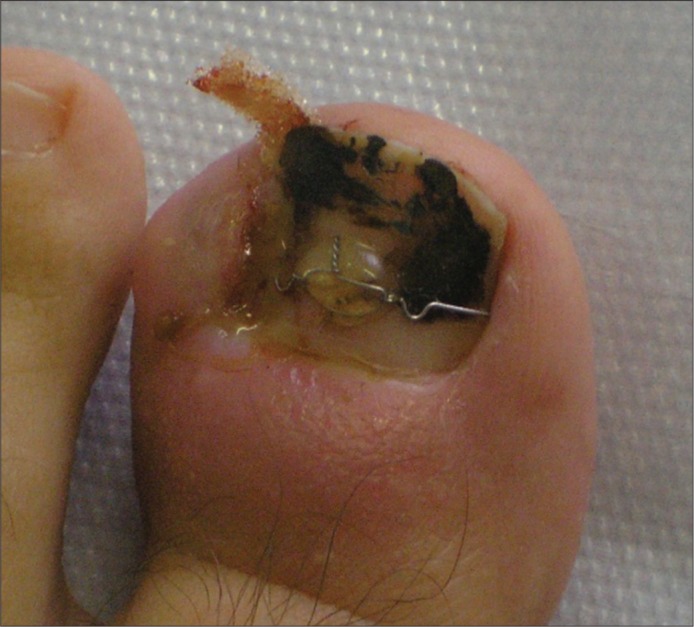Abstract
Nail bracing is a safe, simple, and inexpensive treatment option that avoids surgery, requires no anesthetic, requires no recovery period, allows wearing the existing shoes, offers immediate relief from pain, and allows the practice of daily activities. Braces can be used for prolonged periods of times. If recurrence occurs, reapplication of bracing is usually required.
Ingrown toenails are one of the most frequent nail disorders, with great impact on daily activities, discomfort, and pain. Its pathogenesis is simple: a wide, curved nail plate associated with lateral corners cuts obliquely, leaving a tiny spicule (a small piece of nail) that digs into the lateral nail groove and pierces the epidermis. The result is a foreign body reaction with inflammatory cells, granulation tissue, and secondary infection (1). Candida albicans is a frequent complicating factor in both the causation of an ingrown nail as well as its management. Precipitating factors are narrow pointed shoes, tight socks, hyperhidrosis, and diabetes mellitus (2). There are three stages of an ingrown nail: 1) inflammation, swelling, and pain; 2) inflammation, pain, nonhealing wound and oozing, and granulation tissue; and 3) abscess formation and chronic induration of the lateral nailfold. The treatment is frustrating and difficult for the patients and physicians and is associated with local complications and sometimes permanently distorted toes and nails.
Nail braces were created in 1872 by E. E. Stedman, but their use began in Europe and Australia in 1960. Ingrown toenail bracing was developed in the 1980s by the Institute for Orthonyxia in Erlangen, Germany. Nail bracing is a conservative method used for ingrown nails, applied even in children, patients with diabetes mellitus, and cases of local infection (stage 3). The braces are made from steel wire or plastic bands; the wire is applied over the dorsal surface of the nail and curved under its lateral edges (Figure) (3). A loop bridges the levers and draws them together. The wires are then trimmed and the edges covered with an artificial nail mass to protect footwear. The braces are applied after measuring the nail of the individual, and the pressure is modified monthly based on the presence of symptoms. The administration of antibiotics is controversial, and most favor simple hygienic measures. Braces are removed when all symptoms vanish.
Figure.

Nail brace treatment for an ingrown nail in an active athlete.
References
- 1.Brzezinski P. Assessment of the effectiveness of application antiseptics in prevention of foot skin inflammation. N Dermatol Online. 2011;2(1):21–24. [Google Scholar]
- 2.Brzezinski P. Skin disorders of the foot during military exercise and their impact on soldier's performance. Lek Wojsk. 2009;87(2):80–83. [Google Scholar]
- 3.Talwar A, Puri N. A study on the surgical treatment of ingrowing toe nail with nail excision with chemical matricectomy versus nail excision alone. Our Dermatol Online. 2013;4(1):32–34. [Google Scholar]


